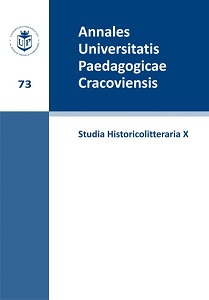Motyw Judasza w literaturze polskiej przełomu XIX i XX wieku
The motif of Judas in Polish literature at the turn of the 20th century
Author(s): Barbara MunkSubject(s): Christian Theology and Religion, Studies of Literature, Polish Literature, 19th Century, Pre-WW I & WW I (1900 -1919), Sociology of Religion
Published by: Wydawnictwo Uniwersytetu Komisji Edukacji Narodowej w Krakowie
Keywords: Polish literature; Judas; 20th centry;
Summary/Abstract: Biblical motifs were used in literature differently, depending on a period, trends in philosophy, views and formed models. For the generation of Young Poland artists, the Holy Bible was evidence of cultural continuity of humanity, and also of its ethical foundation. The Bible was reinterpreted, too. It became a source of religious topics, as well as their inversion or opposition. Two trends of biblical inspirations emerged. The first one is the trend of artistic experiments, innovative, arising from philosophical assumptions of the period. The second trend is conservative, perceiving the Bible as a religious support for everyone. “This first trend dominated modern, avant-garde and artistically ambitious literature, created by the most outstanding writers of the period: Kasprowicz, Wyspiański, Staff, Roztworowski. The second trend could be noticed in literary texts taking up religious issues in a more traditional and popular way, mostly by second-rate artists, going in for literary ‘illustration’ of biblical themes”. Even in the first centuries of Christianity, the figure of Judas Iscariot was a frequent subject in literature. Those texts had influenced his depiction for centuries, and this image was unambiguously negative. The image of Judas – a sinner (a red-haired traitor with hooked chin, dressed in a yellow robe) was partly vindicated only in Modernism, whose range of interest involved controversial individuals. The following texts can be counted among the narrative prose of the turn of the 20th century featuring the motif of Judas: Legenda wigilijna (1889) and Sprawiedliwie (1899) by Władysław Reymont; Przeklęty (1902) by Andrzej Niemojewski; Zwycięzca (1910) by Jerzy Żuławski; Maria Magdalena (1912) by Gustaw Daniłowski; Maria z Magdali (1928) by Józef Jankowski; Nawracanie Judasza (1916) by Stefan Żeromski and Judaszowa wina (1918) by Maria Czeska-Mączyńska. Examples of lyrical prose are: Żywot Zbawiciela Pana Naszego Jezusa Chrystusa spisany wedle Czterech Ewangelii (1880) by Wincenty Popiel; Labirynt (1903) by Natalia Dzierżek; Zgon Judasza (1875) by Józef Grajnert; Mistrz z Nazaretu (1905) by Kajetan Wysłouch; Judasz (1907) by Włodzimierz Sulima Popiel, and anonymous Zdrada from 1925. Poetry works are: Judasz (1901) by Jan Kasprowicz; Ukrzyżowanie and Ostatnia Wieczerza by Stanisław Korab Brzozowski; Judasz (1901) by Władysław Bukowiński; Judasz (1903) by Artur Oppman; Judasz sonnets I, II (1902) by Kornel Makuszyński; Misterium Galilei (1920) by Ludwik Hieronim Morstin; Golgota (1922) by Antoni Waśkowski; Góra oliwna and Uwielbiam, Panie, Twe przebite ręce by Leopold Staff. The last type of texts is represented by the following dramas: Magdalena, czyli rozpacz i nadzieja (1861) by Krystyn Ostrowski; Jeremiasz Prorok (1892) by Michał Żmigrodzki; Maria z Magdali (1906) by Antoni Szandlerowski; Judasz z Kariothu (1913) by Karol Hubert Rostworowski and Judasz (1917) by Kazimierz Przerwa Tetmajer. The attempt to find the answer to the question “what kind of human Judas was?” seems to be the primal reason of choosing Judas as the main character in the majority of the texts. Why did he betray? What were his motives? How was he punished? The issue of guilt and punishment still remains the basic problem. There is a slight shift in looking at Judas, from the damned main character to a miserable man, entangled in his own weaknesses, confronted with the greatness of Jesus, a man that is deeply mortified at the same time, unable to bear his own fate. Judas is depicted in texts of Young Poland partly as a weak and tractable geezer, a cheater greedy for money and honour, and partly as a ruthless mythomaniac without scruple, characterized by strong and destructive personality, while in other texts this character becomes an erotic beast, which could turn out to be a devil incarnate, too. First of all, Young Poland’s Judas is an exponent of the period’s fears. His character provokes reflection on suffering, human free will, human morality and responsibility for deeds, inclination to sin and relation with God. Although Judas is still perceived as a traitor, his deed becomes an impulse to seek motives of this wicked deed, and to reflect on ethics. Modernism might not have managed to fully vindicate Judas, but it made him a multidimensional and tragic character. Over the centuries, Judas, the controversial Apostle, has become a figure of irredeemable sinner and traitor. It is highly probable that the historical Judas wouldn’t recognize himself in his cultural image, elaborately woven for twenty centuries.
Journal: Annales Universitatis Paedagogicae Cracoviensis. Studia Historicolitteraria
- Issue Year: 2010
- Issue No: 10
- Page Range: 110-131
- Page Count: 22
- Language: Polish

